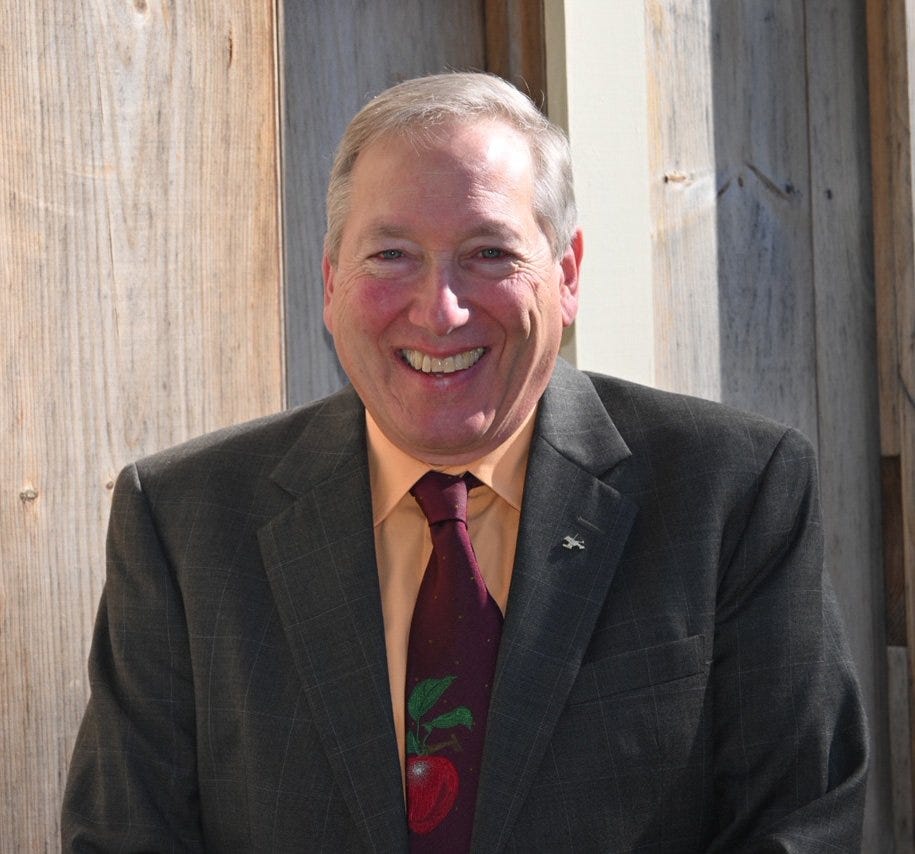Democrats Need to Step Up Rural Engagement:
The DNC Has Struggled--And Still Struggles--To Engage Party Voters And Activists In Rural Areas. Plus, Examples Of Oligarchy In Action
Feel free to check the past Biden Era archives and follow the editions to come in the Trump Era on Substack, Medium, and LinkedIn, including those on the 2024 Autopsy, Bench-Building, DOGE News, Project 2025 Authoritarianism, Progressive Populism, and more (First Come, First Serve!).
Some of the headlines for this week:
Guess what? The DOGE rummaging and raiding of the federal government is not saving taxpayers a single penny via the Wall Street Journal. In fact, spending has increased from Biden to Trump
Trump guts the National History Day competition, something I know from personal experience because my brother David participated in it in middle school, as did a few of my middle school classmates.
Google “Social Security Trump” and you will see all the damage the Trump regime is doing to the previously third rail program
RFK Jr.’s HHS carnage includes cuts to lead poisoning prevention programs, as well as resources wasted on attempts to link all vaccines at large to Autism, while measles cases skyrocket in Texas, Oklahoma, New Mexico, Kansas, and Ohio
In the United States today, we are now deporting legal residents and green card holders like Mahmoud Khalil who disagree with the administration’s political objectives. That is really Stalin-esque
Accusations of insider trading fly around as questions swirl about the timing of NASDAQ stock purchases hours before the tariff pause announcement
Read my brother’s post about how the Trump Tariffs threatened to upend the bond market.
Notwithstanding all those recent headlines, take this one into account: only one rural director hired by the Democratic Party for the 2016, 2020, and 2024 presidential campaigns.
It’s not about timing or bad candidates, or a lack of message. It comes down to being out of touch and unfocused on the basics of rural outreach.
Take Rhode Island as a microcosm of America. The eastern, coastal part of the state has swung even more towards Democrats since 2016 (especially affluent coastal towns near Newport). The rural western half of the state however has increasingly voted Republican. That includes a number of small towns that almost universally voted Democratic as recently as 2012 (only one, Scituate, supported Mitt Romney over Barack Obama then).
Likewise in Southeastern Massachusetts, Donald Trump came the closest of any Republican in recent memory to flipping Bristol & Plymouth Counties in 2024, once areas of textile production anchored by Fall River and New Bedford (as well as Taunton and Brockton).
This is a story of how Democrats once used to not only win, but dominate, blue-collar working class areas, including rural ones.
Every DNC chair in recent memory has claimed to put in place a 50-State Strategy. Only one has truly done so beyond writing a small or large check to the state parties: Howard Dean.
Howard Dean knew this from being Governor of Vermont, a state that is very rural (the largest city, Burlington, has only 40,000 people). You could not just count on urban areas rich in population, but small in land size. You also had to compete in the suburbs where George W. Bush won the 2004 election, as well as cut into the margins of rural voters.
The 50-State Strategy, unlike today’s Democratic Party, was not blind to the need for rural outreach. In fact, it was central to hopes of putting more states and congressional districts in play. To show the significance of such a focus on rural outreach, Democrats won 48% of the rural vote in the 2006 midterm cycle.
Now, Democrats struggle to break a third of the rural vote. Trump won 3/5ths to 2/3rds of the entire rural vote in 2024. The rural vote helped Trump win 31 states and Maine’s 2nd congressional district electoral vote. The answer is simple: Democrats have no electoral infrastructure in Trump Country, especially in Rural America.
The electoral results described above speak to a development that occurred after Howard Dean left the DNC and after the 2010 Midterms. Democrats disinvested from the work of rural outreach, disbanding the Rural Desks at the DCCC, the DSCC, and the DNC altogether. The focus, as Obama’s team looked to, would be the presidential battleground states. Incumbents in red states and congressional districts subsequently retired or ran for higher office, ensuring their seats would flip easily to Republicans in the election cycles to come.
Sound familiar? That was what happened in 2024. After rosy expectations in 2020, Democrats confined their electoral battlefield to the 7 battleground states. What they did not expect was their lack of engagement with blue-collar working class voters would translate either to blowout losses in red states, or closer-than-expected wins in blue ones.
And lessons have not been learned after all. The DNC’s People’s Cabinet unveiling features Democratic officials who lost bids for public office recently—most notably Heidi Heitkamp, who lost her 2018 reelection bid by 11 points. Why is the Democratic Party not including rural voices like Tom Harkin, Byron Dorgan, Tom Daschle, David Loebsack, Glenn Poshard, Baron Hill, Zack Space, Mark Critz, Bart Stupak, David Obey, or even Tim Walz, people who actually won, and live, in rural areas? Why not listen to the voices of those who have seen their communities change overtime, such as Jeanne Poppe, Janet Bewley, Wes Shoemyer, Jerry Costello Jr., Terry Goodin, Lou Gentile, Frank Burns, John Burzichelli, and Michelle Hinchey. Or even Jon Tester and Sherrod Brown, for that matter?
Even more stunning, the new DNC War Room features absolutely no voices from Rural America.
There are also no signs of a Rural Desk being established at the DCCC and DSCC again, or even a strengthening of the Rural Council to a more permanent status in the DNC as a geographic minority (in contrast to racial, ethnic, religious, or other types of coalition groups).
I admit I am not an expert on rural politics. But such kinds of actions, or lack thereof, only serve to disillusion the people on-the-ground who need to be empowered and supported. The result of which is many rural Democrats now register as Independents and/or ignore DNC activities entirely.
So how can this change?
First, Democrats just have to campaign more on rural issues, whether it is agricultural consolidation, farm bankruptcies, broadband access, Medicaid expansion, public school district closures, ethanol production, conservation programs, rural housing supply, forest management, intergenerational poverty, the opioid & fentanyl epidemics, disaster relief, or postal services and banking. These are all rural issues.
Second, Democrats have to confront stereotypes or myths about Rural America. Rural America & Trump Country is not just “Hillbillies and Rednecks.” Rural America encompasses a mix of resort towns and poor areas. It includes predominantly white communities as well as predominantly Black & Latino communities. It includes reservations and communities home to indigenous Native American & Pacific Islander tribes. Undocumented immigrants work many jobs in Rural America, including in agriculture and the meatpacking industry.
We have to understand people and communities beyond the stereotypes, and we have to tailor our message to those different communities, without either misunderstanding them or looking down on them. The days of Clinton’s “basket of deplorables” are over.
Third, Democrats have to acknowledge the changing societal landscape of Rural America which is more than just agricultural. Rural America has challenges of all kinds in its economy from agriculture and manufacturing, to energy production, mining, logging, retail, and hospitality. A number of rural Americans also work for the federal government.
Fourth, Democrats have to restore outreach with expanded infrastructure right now throughout Trump Country. If you don’t compete, you can’t win. That is why the DNC needs a Rural Desk with actual experts and organizers who know what issues to hit on, what ways voters can be reached through rural media, and where resources should be deployed. Having that infrastructure allows a bench of candidates to form in areas that otherwise would be uncompetitive.
And fifth, compete everywhere in the 50 states and various territories; including places Democrats won 12 or 16 years ago. You cannot have a zeal to win over rural voters unless you decide to compete in areas where you need to win over rural voters, whether it is Ohio, Iowa, Indiana, and Missouri, or Texas, Florida, and South Carolina.
Lastly, Democrats are not poor. They have the money to invest in Rural America. The question, as Matt Barron put it back in 2023, before the $1.5 billion presidential campaign faucet turbocharge in 2024, is whether they have the willpower to try something different.







A clarification required from a prominent rural strategist. Thank you for correcting the record:
“The Dems didn't disinvest in rural desks after 2010 because they never had them at DNC, DCCC or DSCC. They pulled the plug on House Democratic Rural Working Group and Senate Rural Outreach which were messaging units housed in the respective House and Senate Dem policy and communications shops.”
Very important message for Democrats today. Thanks Mike!